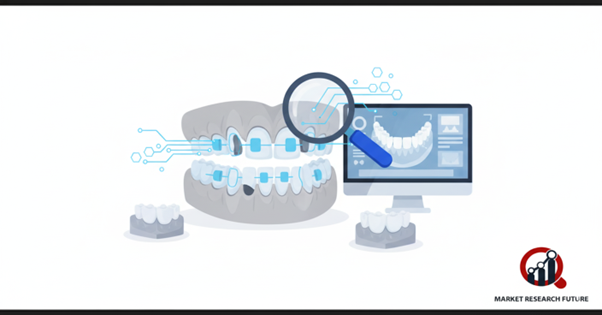A Deep Dive into the Global Malocclusion Market: From Diagnosis to Digital Dentistry

Malocclusion involves teeth misalignment, and it is a common problem that affects everyone and can cause aesthetic and functional problems. While it is often hereditary, it can also result from early childhood habits like thumb sucking, prolonged pacifier use after three, and other dental problems like extra teeth, missing teeth, poor fillings, abnormal jaw shapes, and teeth positioned incorrectly.
Malocclusion can lead to three classes of misalignment, which are Class I, Class II, and Class III. The treatment can vary from mild treatments with braces, jaw stabilization plates, and tooth reshaping to severe cases that may require surgery. These treatments may also result in some problems, which may include pain, trouble chewing, and temporary problems with speaking.
Market Overview: Rising Prevalence Driving Market Expansion
The growing incidence of dental problems and disorders has led to the growth of the global malocclusion market. There is an increasing focus on oral health and aesthetics within the community, and thus, orthodontic treatments are becoming common, particularly in children and adolescents.
A 2017 study in the International Journal of Environmental Research and Public Health noted an 83.9% prevalence of malocclusion in Shanghai and indicated a deep overbite was the most common type and affected 63.7% of children. Such statistics demonstrate the high prevalence of this condition and the increasing need for corrective remedies.
Market growth is also a result of the increase in interest in cosmetic dentistry. Dentistry is no longer confined to the correction of a problematic smile and unhealthy teeth; it is also bolstered by increased social media presence, disposable income, and the obsession to enhance and beautify one’s smile.
Challenges Hindering Market Growth: Slow Tech Adoption and Awareness Gaps
Market growth is further inhibited by the slow dissemination of new technologies. While demand for cosmetic dentistry increases, a noticeable lack of technological understanding impedes growth. This is mostly the case for older dentists, and adding new digital technologies like 3D imaging and AI orthodontics is avoided.
This presents a delay in the modernization of orthodontics, especially in developing countries, and marks a lost opportunity in the efficient treatment of malocclusion.
Key Market Players Driving Innovation
The market for addressing malocclusions is quite active. Many companies have gained a foothold and look to expand their range of products as well as build their market presence globally. They focus on product range expansion as well as strategic mergers and intercorporate alliances.
Dentsply Sirona Inc. — One of the first companies in the world to develop and sell dental products, Dentsply Sirona is also the first to offer a complete range of dental/health care products. Their innovative product and market development is best exemplified by the continuing strategic alliances, such as the one with Healthdent Technologies International for the acquisition of gutta-percha material technologies in 2017.
Align Technology, Inc. — Still first in the digital orthodontics field, Align Technology has expanded its product offering to include the Invisalign clear aligners. With strategic relationships like the one formed with Glidewell Dental in 2017 for the distribution of the iTero Element intraoral scanner in North America, they continue to build their global digital ecosystem.
Many companies have also made a name for themselves, like American Orthodontics, Rocky Mountain Orthodontics. They all focus on product development to ensure competitiveness in the global market.
Improving Reimbursement Policies Fueling Market Growth
The rising burden of malocclusion and its psychological impact are pushing both government and private organizations to improve reimbursement frameworks for orthodontic care. Washington State Health Care Authority is noted as providing coverage for cases where there is severe malocclusion for those under the age of 20. Furthermore, the American Dental Association (ADA) pointed out that Maryland, Utah, Arkansas, and Massachusetts, with Medicaid Fee-for-Service (FFS) reimbursement rates of 74-79% relative to private dental insurance, lead the U.S. in FFS reimbursement rates.
Accessibility of treatment is likely to increase with the reimbursement policy changes. The increase in patients who seek treatment with early intervention for orthodontic conditions will likely follow.
The Future of Digital Dentistry
Innovation and future technologies will define the future of the malocclusion market, specifically with the inclusion of tailored technologies. AI for orthodontic treatment planning, 3D-printed aligners, digital impression systems, and tele-dentistry are just some innovations that are changing how doctors diagnose and treat malocclusion.
Additionally, the increase in the young population, where the focus is on preventive and aesthetic orthodontics, will lead to the increased global demand for malocclusion treatment. The expected growth in reimbursement and the awareness level of the malocclusion treatment will result in growth within the market by 2030.
Conclusion
The global malocclusion market is driven by high aesthetic awareness, the innovative treatment technologies available, and an increase in prevalence. Additional market growth will require a focus on limited technological awareness and access to advanced care within the market. Digital solutions are being adopted, and reimbursement policies from the government are also improving. With so many positive changes, the future of malocclusion treatment is hopeful. The next generation of dental care will be affordable and aesthetically pleasing, treating malocclusions with precision.